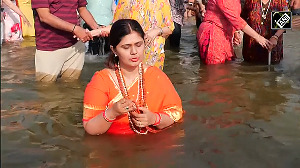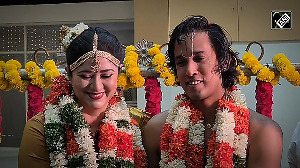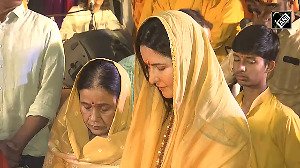In the absence of the over-arching ‘Jaya charisma’, EPS has to convince the AIADMK’s traditional constituencies, including those in his western districts, that his leadership would stand up against the BJP-led Centre even in a post-poll scenario, a la Jayalalithaa, and would not yield as much as party founder MGR had done, says N Sathiya Moorthy.

With parliamentary polls not too far away, speculation in the media in Tamil Nadu is all about the ruling AIADMK having a poll alliance with the BJP-NDA counterpart at the national level, and possibly at the latter’s instance and insistence -- and on their terms, too.
Should such a situation emerge, Chief Minister Edappadi K Palaniswami, or, EPS, may have to prove more for the self and the party than he has been able to do since coming to power in the midst of the post-Jayalalithaa splits and confusion that has seen him emerge stronger of the lot -- and with each passing day.
There is no denying that quietly and efficiently, EPS has taken over the party and convinced the AIADMK’s unsure cadres that he is their go-to-man in these times of crises and continuing confusion. He has faced off threats from within and outside of the AIADMK hierarchy, to his leadership, the former from his predecessor and incumbent deputy chief minister, O Panneerselvam, and the latter from the breakaway faction under T T V Dhinakaran, nephew and chosen political heir of jailed Jaya aide, V K Sasikala Natarajan.
Better still for the party is that EPS has faced off legislative threats and legal challenges to his government’s majority with astuteness that Tamil Nadu watchers are wont to confer only on the late rival DMK supremo, M Karunanidhi. By the same token, he may have also appealed to the non-traditional ‘Jaya voters’ who were not AIADMK members but saw her ‘more decisive and effective’ as chief minister than Karunanidhi -- even while conceding that all politicians and political parties, including the two ‘Dravidian majors’, were corrupt and nepotistic, one way or the other.
Be it in the handling of the ‘NEET issue and protest’, the on-again-off-again agitations by state government employees and teachers, or effectively implementing decisions, even if taken under court duress, EPS has shown that he can do it the Jaya way -- and without her charisma and the public controversies attending on her perceived mode of enforcement.
Even on the controversial eight-lane Chennai-Salem highway, where courts have halted his government’s fast-track approach to land takeover, etc, EPS’s decisive ways have won over admirers from the ‘development constituency’ of the Jaya kind, though not as many critics and victims of the project, as he alone managed to make. Less said, however, about the state government’s handling of the ‘Sterlite issue’ in southern Thoothukudi, where the death of 13 protestors in police firing, did force the EPS leadership to re-visit its earlier position and clamp down on the continued operations of the private sector copper smelter.
It is thus that EPS has shown that he could let government employees’ agitation(s) fizzle out than putting them down with her proverbial iron hand as Jayalalithaa had done in 2003. The sacking of a hundred thousand employees overnight, and the midnight raids on their official quarters all made the Jaya leadership unpopular even with her traditional constituencies ahead of the crucial Lok Sabha polls of 2004.
It has been very different under EPS’s guard -- twice in as many years -- though he can forget a substantial share of the high 20-25 per cent government employees’ ‘constituency’, comprising 1.2 million staff and another half a million pensioners -- and their families. Under Jayalalithaa in 2004, the AIADMK lost almost all of the ‘government employees’ constituency’, even though she got high praise from the Supreme Court and editorial writers of national newspapers.
More recently, the EPS government has been enforcing the ‘plastic ban’ since New Year, but without all the hullabaloo and overstated praise that attended on Jayalalithaa’s ‘forced implementation’ of even more beneficial schemes such as ‘rain water harvesting’. Even in terms of the recently-concluded Global Investor Meet, the EPS leadership left it bereft of the colour and pomp that attended on Jaya’s initiative in her fifth term as chief minister (2011-16) -- and so, too, without the attendant public controversies of those times, which went beyond ‘motivated political criticism’ of whatever kind.
What really comes of GIM-2019 may become inconsequential, if the EPS leadership does not ultimately do well on the performance scorecard, but then it would not occupy as much media space as Jaya’s GIM 2015, in the absence of recurring controversies of the kind. The fact was that even the ‘foreign investors’ that Jaya sought to woo as a ‘praised package’ to her constituencies nearer home, were not impressed either with the offerings or the pageant that was put up for their benefit.
If EPS has thus quietly taken over the party machinery and also re-captured the imagination of the traditional AIADMK and not-so-traditional ‘Jaya voters’, he has also his own politico-electoral woes that he cannot put off, this time round.
Indications are that the BJP at the Centre has been wooing/pressuring the AIADMK leadership, almost since Jayalalithaa was hospitalised in September 2016, and more so afterwards, for an early alliance for the upcoming Lok Sabha polls of May 2019. The party has hemmed and hummed thus far, but not anymore. This would also be EPS’s test from within the party and outside.
There is no denying the emergence of a stronger anti-BJP ‘minority vote-bank’ in Tamil Nadu since the NDA came to power at the Centre in 2014. Betting on the same and needing the same even more, rival DMK leader M K Stalin has been going hammer and tongs at the BJP leadership of Prime Minister Narendra Modi, especially over the past couple of months.
In the same vein, he went ahead and declared Congress president Rahul Gandhi as his party’s prime ministerial choice, possibly without consultation with other regional parties and probably without even informing his own second line. This, the DMK strategists close to Stalin seem to feel would (alone) ensure complete transfer of the minimalised Congress vote-bank in the state, and more so the substantial and even more consolidated ‘minority/Dalit vote-bank’ in DMK’s favour.
Under Stalin, the DMK has regained its public image as a ‘cadre-based party’, which it had originally gained -- and lost, too -- under predecessor and father, Karunanidhi. The positive public image of Stalin from his days as the first directly-elected mayor of Chennai Municipal Corporation over 20 years ago also lingers in the middle-aged voter population. Whether it may come in handy for the DMK-Congress combine in the parliamentary polls, as much as in the assembly polls of 2021, remains to be seen -- even granting that much of the ‘2-G odium’ from elections 2014 may have died a natural death already.
The problem for EPS and the AIADMK in having a pre-poll tie-up with the BJP is two-fold, or even multi-fold. One, there is greater traction for the BJP among ‘soft Hindutva’ voters, who are an emerging phenomenon over the past nearly two decades, as much in ‘Dravidian’ Tamil Nadu as elsewhere across the country. In elections 2019, their numbers may not be as high as seven per cent as it was for BJP’s Vajpayee (1998-99) and Narendra Modi (2014), but could well be more than the party’s traditional 2-3 per cent, as evidenced whenever it had contested the polls on its own.
The EPS leadership may be unsure if those BJP’s votes could become transferrable to the AIADMK without an electoral alliance. This is because the AIADMK needs its own share of the ‘minority votes’, which Jaya’s ‘Modi vs Lady’ campaign call settled for the party in elections 2014. They need the ‘BJP votes’, not the BJP per se if they could help, as the AIADMK needs its own share of the ‘minority/Dalit votes’ even more, especially for the assembly polls, which are due two years hence, by 2021, if not earlier.
In the absence of the over-arching ‘Jaya charisma’, EPS has to convince the AIADMK’s traditional constituencies, including those in his western districts, that his leadership would stand up against the BJP-led Centre even in a post-poll scenario, a la Jayalalithaa, and would not yield as much as party founder MGR had done -- as only their common DMK rival Karunanidhi too was often seen as doing.
The problem for EPS here is that he needed proving his credentials on this score, pre-poll, not post-poll, when Jayalalithaa too was dithering under similar circumstances in her time. But GenNext voters do not know that part and act of Jayalalithaa, not that they know anything about the MGR leadership even otherwise – barring, of course, his electoral legacy in the ‘Two Leaves’ party symbol.
There is certainly a growing rank of pan-Tamil political sympathisers in every party across Tamil Nadu in recent years, as was the case only at the height of the ‘anti-Hindi agitation’ of the mid-’60s. To these constituencies, the ruling party at the Centre, this time round, the BJP under PM Modi, are the ‘bad guys’ when it came to issues and projects pertaining to Tamil Nadu and the Tamils.
To them, NEET was bad as it truly would impact on public sector medi-care and the doctor-patient ratio in the state, over a period, going beyond the immediate loss of ‘medical seats’ for students from rural Tamil Nadu, as highlighted by the ‘Anitha suicide’ in the first year of the court-ordered nationwide common entrance examinations in 2017.
The Sri Lankan fishers issue, the Cauvery water dispute with neighbouring Tamil Nadu, the Centre’s handling of the ‘Ockhi cyclone’ relief and rehabilitation work are all of greater concern. There is thus the internal contradiction in every political party in the state, including possibly the BJP, where cadres and voters alike are upset over the Modi Centre’s role, and/or non-role.
On issues such as GST and demonetisation, and the more recent core issue of unemployment, EPS’s industry-laden western districts have a lot to complain against the Centre. This has also been a traditional stronghold of the AIADMK, which has beaten the rival DMK hollow in successive elections in this region. Any over-identification of the AIADMK with the BJP ruling the Centre at this stage, could not only weaken the party in the western region in elections 2019, but it could also weaken EPS’s own command of the party, post-poll.
Underlying the unmentioned tensions in the AIADMK is the West-South divide in the party, where EPS comes from the former and OPS represents the latter. Stripped of regional identities of the kind, the Vellalar Gounder community from which EPS has emerged and the Mukkulathore castes of which OPS has been the frontal representative from Jaya’s time, have been traditional backers of the AIADMK, since MGR’s time. With both MGR and Jaya coming from outside of these caste groupings, they could ride over them both at the same time. Not anymore.
Already weak and hurt, the OPS camp would be braying for an opportunity to hit out at EPS, especially if the latter were ready to provide one. Both sides are also aware that OPS has been rendered relatively weak, more than what EPS’s machinations could do, owing to the split in the Mukkulathore ranks within the AIADMK, between OPS and TTV. It is also one reason why the EPS camp is dead set against the re-merger of AIADMK and TTV-led AMMK, which the BJP is said to be desirous of.
But then from within, EPS is also set against a western Gounder veteran in Lok Sabha, Deputy Speaker M Thambidurai, who has been constantly pouring cold water on any electoral tie-up with the BJP. So have been other Gounder veterans of the C Ponnaiyan kind, also from the region -- who otherwise feel sidelined in EPS’s scheme of things for the AIADMK.
In the larger , post-Jaya, post-Karuna ‘Dravidian’ political context, prima facie, this is an occasion for the non-charismatic rival leaderships of EPS and Stalin to wipe out the ‘national BJP alternatives’ of their times, as MGR-Jaya on the one hand and Karunanidhi on the other, had done with the Congress and communist parties, in theirs.
However, the situation could become trickier for EPS and the AIADMK, if the BJP does not require whatever Lok Sabha seats they may have won, to form a ‘stable government’ at the Centre. It could be that the AIADMK wins or loses seats in the state, but the BJP-NDA does not require them to form a government, in the absence of a pre-poll alliance.
It could be worse for the AIADMK and EPS, if they do not get a government at the Centre that did not require their MPs for survival -- that too if the party performs creditably in the parliamentary polls, even if not winning the high 37 of 39 seats that Jaya had swept in 2014.
An interesting situation could be if the AIADMK has seats to offer, and a non-BJP, non-Congress Third Front emerges at the Centre, post-poll, as in 1996 and 1998. Having identified itself too much with the Congress and Rahul Gandhi for prime minister, the DMK may feel shy to approach the new formation as confidently as it did in 1996.
But an AIADMK sans BJP alliance, if it has MPs to offer, could become central to the formation of a new government at the Centre, at least from a Tamil Nadu perspective, as only MGR had done with the failed Charan Singh leadership in 1979, when for the first time, a Dravidian party had ministers at the Centre -- however controversial and however short-lived it was.
N Sathiya Moorthy, veteran journalist and political analyst, is director, Observer Research Foundation, Chennai chapter.











 © 2025
© 2025